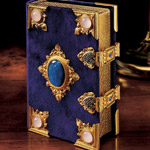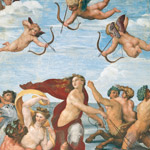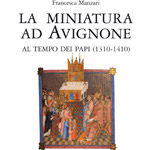Treasures from the world of the arts: the Franco Cosimo Panini Editore team takes great pride in its art books, covering a vast range of themes.
From the very outset, Franco Cosimo Panini Editore has paid special attention to its publications of excellence, its art books and its historical and cultural publishing work in general. Given the undoubted scientific and artistic worth of its editions – ranging from precious limited-edition facsimiles to limited print-run history of art publications – Franco Cosimo Panini Editore is considered one of the most authoritative publishers in the field. The publishing house takes great pride in the "Mirabilia Italiæ" series (dedicated to the major works making up our artistic heritage) and "La Biblioteca Impossibile" (facsimile editions of Renaissance illuminated manuscripts). Noteworthy, too, among our publications is the popular series (produced with the imprimatur of Nobel Prize-winning playwright, Dario Fo) dedicated to Italy's great painters. The publications were inspired by Fo's immensely popular theatrical history of art lessons.
"La Biblioteca Impossibile" is the name of a series of extremely faithfully reproduced full facsimiles of the greatest Renaissance masterpieces of the art of illumination.
 "La Biblioteca Impossibile" is a series of facsimile reproductions of Renaissance illuminated codices. The project started up in 1994 with the facsimile edition of a bible (Bibbia di Borso d'Este). This series presents faithful reproductions of absolute masterpieces of the art of illumination in Italy. The works have been selected on the basis of their wealth of adornments, their considerable historical and artistic significance, and the importance of the patrons who originally commissioned them. All the reproduced codices once belonged to the leading noble houses of the Renaissance period in Italy, such as the Medici, Visconti, Aragona and Farnese families. Readers will be able to admire, first hand, works of such value that they must be stored in the strong rooms and vaults of the world's leading libraries, hidden away from the general public. As world-renowned novelist and scholar Umberto Eco has also pointed out, facsimiles are instruments of great scientific value. Eco writes, "For the first time, researchers and students can study, examine and touch works which are usually buried in the safes of public libraries". "La Biblioteca Impossibile" has published twelve works to date.
"La Biblioteca Impossibile" is a series of facsimile reproductions of Renaissance illuminated codices. The project started up in 1994 with the facsimile edition of a bible (Bibbia di Borso d'Este). This series presents faithful reproductions of absolute masterpieces of the art of illumination in Italy. The works have been selected on the basis of their wealth of adornments, their considerable historical and artistic significance, and the importance of the patrons who originally commissioned them. All the reproduced codices once belonged to the leading noble houses of the Renaissance period in Italy, such as the Medici, Visconti, Aragona and Farnese families. Readers will be able to admire, first hand, works of such value that they must be stored in the strong rooms and vaults of the world's leading libraries, hidden away from the general public. As world-renowned novelist and scholar Umberto Eco has also pointed out, facsimiles are instruments of great scientific value. Eco writes, "For the first time, researchers and students can study, examine and touch works which are usually buried in the safes of public libraries". "La Biblioteca Impossibile" has published twelve works to date.
The guiding principle behind "Mirabilia Italiæ" is foregrounding the illustrations. "Mirabilia Italiæ" is a series of publications dedicated to Italy's major artworks.
 "Mirabilia Italiae" is a series of publications dedicated to Italy's major artworks. The guiding principle behind this project, under chief editor Salvatore Settis, is foregrounding the illustrations. The idea is to provide exhaustive, definitive photographic documentation of the works dealt with. With its thousands of stunning photos, taken during campaigns conducted specifically for the purposes of the project, "Mirabilia Italiæ" provides 'visitors' to our artistic heritage with an itinerary, complete with explanatory notes. Each work of the series is made up of a photographic Atlas and a volume of Texts, with information on all the illustrations appearing in the Atlas. Also included are the contributions of such renowned scholars as Lucio Gambi, Antonio Pinelli, Antonio Paolucci, Adriano Peroni, Clementina Rizzardi, Patrizia Angiolini Martinelli, Amedeo Belluzzi, Chiara Frugoni and Giorgio Bonsanti. In recognition of the excellence of the "Mirabilia Italiæ" series, on 29 January 2003, Franco Cosimo Panini Editore received the Premio alla Cultura award for 2002. The award is an initiative of the office of Italy's Prime Minister.
"Mirabilia Italiae" is a series of publications dedicated to Italy's major artworks. The guiding principle behind this project, under chief editor Salvatore Settis, is foregrounding the illustrations. The idea is to provide exhaustive, definitive photographic documentation of the works dealt with. With its thousands of stunning photos, taken during campaigns conducted specifically for the purposes of the project, "Mirabilia Italiæ" provides 'visitors' to our artistic heritage with an itinerary, complete with explanatory notes. Each work of the series is made up of a photographic Atlas and a volume of Texts, with information on all the illustrations appearing in the Atlas. Also included are the contributions of such renowned scholars as Lucio Gambi, Antonio Pinelli, Antonio Paolucci, Adriano Peroni, Clementina Rizzardi, Patrizia Angiolini Martinelli, Amedeo Belluzzi, Chiara Frugoni and Giorgio Bonsanti. In recognition of the excellence of the "Mirabilia Italiæ" series, on 29 January 2003, Franco Cosimo Panini Editore received the Premio alla Cultura award for 2002. The award is an initiative of the office of Italy's Prime Minister.
The Nobel Prize-winning playwright, Dario Fo, provides an account of who the great personages on the stage of the history of the arts really were. With a touch of irony and all the passion of a true art-lover, Fo delves into the secret lives of the great geniuses of the past.
 Dario Fo's books (all edited by the actress, Franca Rame) are dedicated to Fo's remarkable and highly popular lessons on the history of art. The series is the fruit of theatrical show-lessons of recent years, written by Fo, who took to the stage – not as an actor or entertainer but as a teacher. These show-lessons, which were very well received by his public, provided Fo with an opportunity to consider the lives of painters such as Giotto, Mantegna, Leonardo and Caravaggio, and to examine these artists and their works through the double prism of the artists' personal lives and their significance as artists. Alongside the figures illustrating the paintings described, and Fo's own extraordinary drawings, we note the author's frank approach to his topics. Indeed, his commentaries carry with them more than a hint of irony.
Dario Fo's books (all edited by the actress, Franca Rame) are dedicated to Fo's remarkable and highly popular lessons on the history of art. The series is the fruit of theatrical show-lessons of recent years, written by Fo, who took to the stage – not as an actor or entertainer but as a teacher. These show-lessons, which were very well received by his public, provided Fo with an opportunity to consider the lives of painters such as Giotto, Mantegna, Leonardo and Caravaggio, and to examine these artists and their works through the double prism of the artists' personal lives and their significance as artists. Alongside the figures illustrating the paintings described, and Fo's own extraordinary drawings, we note the author's frank approach to his topics. Indeed, his commentaries carry with them more than a hint of irony.
Excellence in content matter: the series dedicated to illuminated manuscripts, books on the city of Modena, photography books, essays on art and archaeology.
 The publishing house's Art catalogue includes more than 300 publications, making up more or less 15 series. A key item is the series dedicated to illumination, each volume of which has been curated by top scholars within their respective fields. Given the very high quality of these critical writings (which have frequently occasioned major discoveries), academics have come to consider this series the most authoritative in regard to the various aspects of the art of illumination as practised during the Middle Ages and the Renaissance period.
The publishing house's Art catalogue includes more than 300 publications, making up more or less 15 series. A key item is the series dedicated to illumination, each volume of which has been curated by top scholars within their respective fields. Given the very high quality of these critical writings (which have frequently occasioned major discoveries), academics have come to consider this series the most authoritative in regard to the various aspects of the art of illumination as practised during the Middle Ages and the Renaissance period.
We should also note the publications dedicated to the history of Franco Cosimo Panini Editore's 'home town', the city of Modena. Indeed, our city was the subject of the very first book bearing the Panini imprint – a transcribed Renaissance chronicle of events in Modena, with added comments.
Alongside its popular art and archaeology publications, a number of Franco Cosimo Panini Editore's non-fiction works have also looked into more markedly contemporary developments within the field of the arts (e.g. photography and street art).
